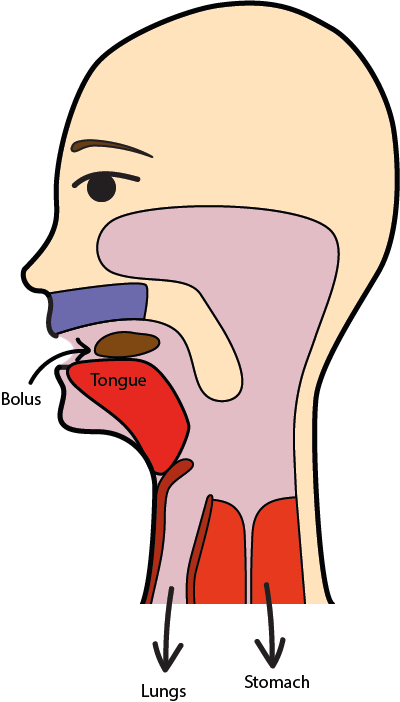Teri
Here is one of the most strange events that happened to me when I was a child.
It’s 3:16 in the morning. I hear something in the cornfields outside of my window. I gaze out of the window and see a dragon with transparent skin and . . .
No!!!!!!!!!!! No more dragon references!!!!!
But this is a true story, and it relates to digestion.
There are no dragons!!!!
Tell that to Frank.
Frank?
Yeah, Frank. The transparent-skinned dragon who lives in my cornfield.

Alright. I’ll talk about Teri instead.
Dare I ask? Who’s Teri?
Teri is a vegan burger.

Teri the Vegan Burger
Teri is a vegan burger about to meet her destiny, your gastrointestinal tract (GI tract) and body cells. A vegan burger is a meatless burger that contains the texture and taste of meat. It provides plenty of protein, unsaturated fat, and carbohydrates. Digestion is a process that will convert Teri into little food pieces and monomers(amino acids, fatty acids, and simple sugars). Teri’s monomers will absorb into your blood, where your body will be using the monomers to make structural proteins and enzymes, fat and steroids, and carbohydrates for energy. In other words, Teri is about to become one with you and your poop.

Propulsion, Secretion, Digestion, Absorption, and Excretion
Propulsion
Swallowed food moves through the gastrointestinal (GI) tract via peristalsis. Surrounding most of the GI tract is a smooth muscle layer that produces strong wave-like contractions, called peristalsis, that propel food. Peristalsis begins in the esophagus and ends in the rectum.

Secretion
The salivary glands, pancreas, liver, stomach, and gallbladder secrete enzymes, hydrochloric acid, bile, and pancreatic juice into the GI tract. This slurry of digestive juice is critical for digestion.


Digestion
Digestion is a catabolic process. Teeth and bile break big pieces of food into smaller pieces via mechanical digestion. However, the smaller pieces of food are not chemically changed. Enzymes in saliva, gastric juice, and pancreatic juice chemically digest the carbohydrates, proteins, and lipids into monomers.



Absorption
The food monomers and most water in food and drink diffuse through the small intestine lining into the blood via absorption. Most of the remaining water in the undigested food is absorbed through the lining of the large intestine.

Excretion
The end of the large intestine compacts the undigested food and remaining water into feces (poop). The feces is excreted during defecation (pooping).

This is an artistic rendition of poop. Most poop does not stare and smile.
The Gastrointestinal (GI) Tract
The gastrointestinal (GI) tract is about twenty feet long and spans from the mouth to the anus. The GI tract is essentially a tunnel through your body where food enters from one end and feces (poop, dookie) leaves the other end.

The Oral Cavity: Where Digestion Begins
Digestion begins in the mouth, where the enzyme amylase in saliva catabolizes (digests) the starch in Teri’s bun and patty into simple sugars. The teeth cut and smash Teri into smaller pieces, and the tongue rolls her into a moist ball called a bolus.
| Mechanical Digestion | Chemical Digestion | Absorption of Food into the Body |
|---|---|---|
| The teeth turn big food chunks into small food chunks; tongue movements roll the food into a bolus | Salivary amylase catabolizes starch into simple sugars | None |


The Esophagus: Where Peristalsis Begins
Teri, now a bolus, is swallowed and moves down the esophagus towards the stomach via peristalsis. A circular valve-like muscle called the cardiac sphincter (aka the lower esophageal sphincter) acts as a door separating the stomach from the esophagus.
| Mechanical Digestion | Chemical Digestion | Absorption of Food into the Body |
|---|---|---|
| None | None | None |

The Stomach: Where Protein Digestion Begins
The cardiac sphincter opens, and Teri falls into a pit of hydrochloric acid, mucus, and enzymes known as the stomach. Hydrochloric acid kills pathogens on Teri and activates the enzyme pepsin. Pepsin chemically digests Teri’s protein into amino acids. The contractions in the stomach’s muscular walls churn and mechanically digest Teri until she becomes a thick solution called chyme.
| Mechanical Digestion | Chemical Digestion | Absorption of Food into the Body |
|---|---|---|
| Stomach contractions convert the bolus into chyme | Pepsin catabolizes proteins into amino acids | None |

The Small Intestine: Where the Majority of Digestion and Absorption Happens
The Duodenum – Segment of the SI Where Most Digestion Occurs
Teri, now chyme, leaves the stomach through the pyloric sphincter muscle and enters the duodenum, where she meets a slurry of bicarbonate ions, bile, and digestive enzymes. The bicarbonate ions(HCO3–) raise the acidic chyme (Teri) from pH 2 to pH 6, so the chyme does cause an ulcer or denature (destroy) digestive enzymes.

The pancreas secretes a digestive juice into the duodenum containing most enzymes that will chemically digest Teri into monomers. The liver secretes bile that emulsifies (a type of mechanical digestion) large fat droplets into baby droplets.
| Mechanical Digestion | Chemical Digestion | Absorption of Food into the Body |
|---|---|---|
| Bile emulsifies large fat droplets into small fat droplets | Trypsin catabolizes proteins into amino acids; amylase catabolizes starch into simple sugars; lipase catabolizes fats into fatty acids | Some amino acids, fatty acids, simple sugars, and water in the chyme |


The Jejunum and Ilium – Segment of SI Where Most Absorption Occurs
After Teri, still chyme, is digested, she moves to the jejunum and ileum, where her monomers and water will move into the blood. The small intestine is the most extended segment of the gastrointestinal tract; however, it has a smaller diameter than the large intestine. Therefore, the width, not the intestine’s length, determines its size (large or small).

The small intestine wall consists of valleys and hills called villi, and the villi have cells with microvilli. The villi increase the small intestine’s surface area by 30 fold, and the microvilli increase the surface area by 600 fold, increasing the digestion rate and amount of digestion and absorption of food and water. The small intestine is about 15 feet long and has a one-inch diameter. If the small intestine did not have villi and microvilli, its surface area would be about 49 square feet. However, the villi and microvilli increase the small intestine’s surface area to a whopping 2,700 square feet, about a tennis court’s size.
| Mechanical Digestion | Chemical Digestion | Absorption of Food into the Body |
|---|---|---|
| The small amount of protein, lipid, and carbohydrate digestion | Small amount of protein, lipid, and carbohydrate digestion | Most of the amino acids, fatty acids, simple sugars, and water in the chyme |

The Large Intestine: Home of the Gut Microbiome
The remaining undigested food moves into the large intestine through the ileocecal valve(a sphincter muscle). The large intestine is shorter than the small intestine but has a larger diameter. Most of Teri’s remaining water diffuses through the large intestine walls into the blood.
The large intestine is home to trillions of bacteria that comprise your gut microbiome. How gut bacteria affect our biology is still relatively unknown, but we know we cannot survive without them. For example, certain gut bacteria synthesize vitamin K, which aids in blood clotting.
| Mechanical Digestion | Chemical Digestion | Absorption of Food into the Body |
|---|---|---|
| Compaction of undigested food | Gut bacteria catabolize some of the remaining carbohydrates left in the chyme | Most of the remaining water and a few nutrients (vitamin K) in the chyme |

The Rectum
After absorbing most of the remaining water in the undigested food, it solidifies and moves into the rectum. Teri is now feces (poop, dodo) and will leave the rectum during defecation (pooping).
| Mechanical Digestion | Chemical Digestion | Absorption of Food into the Body |
|---|---|---|
| None | None | None |

AP Biology and Physiology Prep
Thinking of taking Physiology in your junior or senior year? If so, click here for a more in-depth look at digestion.